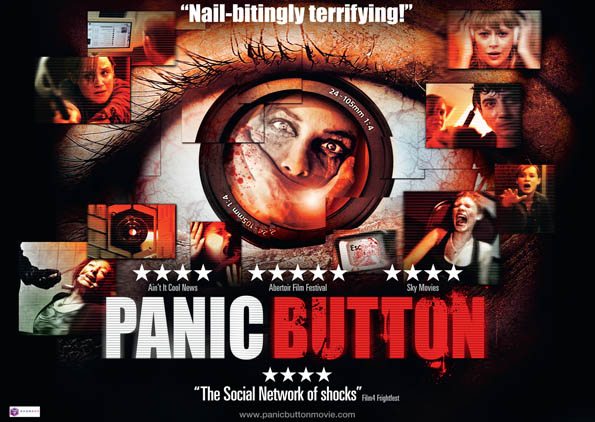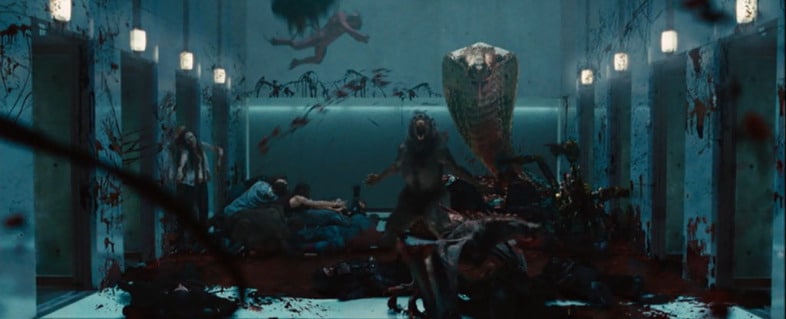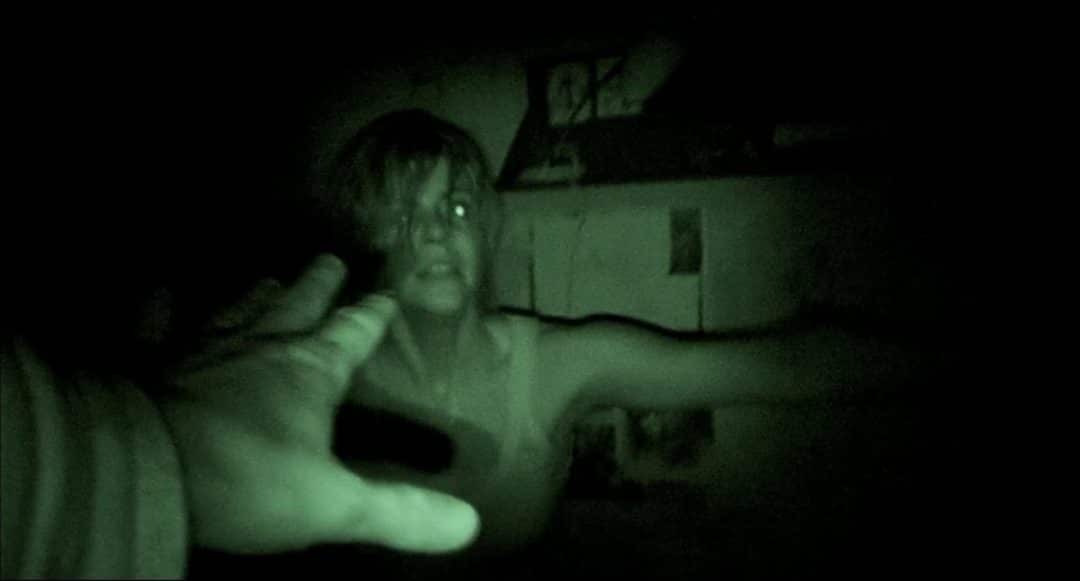For the first part of Keri’s article, please click here.
‘Keep Filming…’
It would be borderline impossible to write about the horror of the first two decades of this century without mentioning a phenomenon which, like ‘torture porn’ cinema, has been rather divisive. I’m talking about the found footage craze – and I think ‘craze’ is a fair term for it, as post-Blair Witch scores upon scores of filmmakers wanted in on the relative ease, accessibility and profit that the form offered. As technology improved and came down in price, leading to the rise of digital media which made it far easier to shoot and edit entire projects, many more would-be directors found themselves able at last to make their own movies. In many respects, this is a positive: it led at least to an extent to a democratisation in filmmaking, where people were no longer excluded from the game simply by a dearth of equipment and funding. However, when you open a floodgate, all manner of material gets through, and some of the affordances of ‘found footage’ soon began to feel just as much like limitations, quickly hardening into cliches of their own.

At its best, the found footage sub-genre has provided us with films such as the [Rec] (2007+) franchise, its very title coming from the ‘record’ function which displays on most camcorders when recording is taking place; utilising a plausible reason for the filming, as well as decent performances, the [Rec] films successfully exploit a sense of unfolding panic as events in a Spanish apartment building spiral quickly out of control. The ‘night vision’ setting is used to particularly good effect here, as the camera becomes a necessary tool to enable the person using it to face down whatever is out to get them, rather than simply being there to get footage. The films were successful enough in their own right to spawn a number of imitators and reboots. Other good examples of the genre include Cloverfield (2008), where videocam is pitched against something absolutely vast in scale, and The Bay (2012), which has enough about it to maintain interest as a host of aquatic parasites besiege a small seaside community. As time has passed, people have reached that little bit further looking for new threats to explore, meaning that most of horror’s classic monsters have been refracted through a shaky camera by now – anything from ghosts to dinosaurs to Bigfoot have had the found footage treatment, with variable outcomes.
One of the great issues which has come to trouble the subgenre, though, is creating an adequate reason for doing so much filming in the first place. Many filmmakers are half-aware of the issue, and will often have characters ask one another, ‘What are you doing? Why are you filming this?’ Well, the question isn’t often adequately answered, and in haste some filmmakers have failed to account for how their film has ostensibly come together in the first place (was it genuinely ‘found’ in this state, or has someone edited it, or..?) Add to that the often unpleasant sensation of motion sickness which can come about, not to mention the utter saturation of the horror market with films of this ilk, and it’s not too great of a leap to see why certain fans (self included) came to get a certain sense of dread when the next low-budget, handheld camera movie came around. To me, some of the best films which use this technique blend it with more conventional filmmaking elements, such as utilising some recovered footage segments alongside, say, mockumentary elements. The absolute best of these, and one of the most unfairly overlooked horror films of the past twenty years, is Lake Mungo (2008). When a teenage girl is found drowned in a lake near her home, her family soon become convinced that she is still with them somehow, and they start to see her in home movies and photographs. They speak to a film crew about their experiences, as slowly they begin to piece together events leading up to Alice’s death. It’s a deeply effective, unsettling film with just the right balance of video footage against more conventional shooting styles.

Other effective found footage titles have started to draw their found footage from the still relatively new world of social media and online interaction: this is to be expected, as social media is now so deeply entrenched in people’s lives, not to mention frequently implicated in the real-life horrors of bullying, doxxing, stalking and all manner of charming human behaviours. Unfriended (2014), which unfolds in real time, is rather better than I expected it to be and weaves together some genuinely unpleasant scares, bringing together online chats, YouTube footage and social media in a very up-to-date supernatural horror. I think that this will continue to be a rich source of horror from this point in; we’ve already had entire films shot on an iPhone (such as To Jennifer in 2013) so as our relationship with ever-augmenting tech continues, the horror potential will doubtlessly continue to grow.
Social Media Horrors
By no means is found footage the only place where we see social media get examined and taken through to extreme, though perhaps not impossible conclusions. If a constant source of anxiety and horror is losing agency, whether through being locked in a castle or tied to a damn chair, then living in a world where all of our deepest, darkest secrets could potentially be accessed and exposed online is a sure fire source for horror, a ‘what if?’ which is, let’s face it, far from impossible. In 2018’s Assassination Nation, a vast data breach threatens to expose the secret lives of townsfolk in small town USA; the resulting hysteria creates a very modern witch hunt as people suddenly see one another as they perhaps really are; it’s an uneasy watch.

Aspects of online interaction can also be extremely lucrative whilst inducing people to behaviour they might not otherwise accept or practice. An early, and excellent example of this came with 2011’s Panic Button. Riffing on the popularity of reality TV, the film followed the fortunes of four competition winners, treated to an all-expenses flight by a popular social network called All2Gethr.com. However, the experience soon turns increasingly nasty as the contestants realise they have been spied on and exposed, before being coerced into taking part in cruel online games which pit them against one another. The increasing potential for online stardom in the new age of the vlogger has given rise to several other recent films, several of which marry the idea of ‘torture porn’ with live streaming, thus providing some justification for the horrors unfolding: people are getting maimed for clicks and comments. As an example, Finale (2018) takes a recognisable premise – kidnap – and turns it into something akin to an old horror host set-up, except the very real torture he presides over is unfolding live online. Making Monsters (2019) pitches a successful YouTube couple against a more savage version of same, swapping their highly successful pranks for something altogether worse which they must battle to escape. It seems highly likely that we will get more films in a similar vein, clear evidence to my mind of ‘dark web’ paranoia and a fear of the loss of control (and in fact, the Unfriended sequel in 2018 had ‘Dark Web’ in its title.) God knows what screenwriters will ever do if we get exhaustive WiFi access, though: horror still seems to depend on phones which suddenly stop working…
Self-Aware Horror…
Another phenomenon which has grown and developed during this century so far stems – to a large extent – from the sheer length and breadth of the horror movie tradition, now that it is over a century old. We as audiences have access to a vast amount of that legacy, and the more we see, the more we might come to recognise trends, or tropes – just as I’m doing here. The other side to that is fans frequently have more of an idea of what to expect; they can delineate the features of a slasher film, for example, or consider likely outcomes. The same goes for any subgenre within horror, and it has doubtlessly become harder and harder for filmmakers to land the element of surprise or even garner some aspects of reinvention to keep their audiences engaged.
One solution has been to challenge the conventions of horror cinema from outside – by deliberately stepping outside the anticipated narrative, disrupting the ‘fourth wall’ that typically divides audience from on-screen events. One such film is Funny Games (2007, though this is a remake, almost frame by frame, of the 1997 version of same). During one scene, it seems as though Ann (Naomi Watts) has been able to turn the tide against her two male aggressors, grabbing a gun and shooting one of them; however, this potentially redemptive scene then actually rewinds on-screen, resuming the previous storyline. It’s a strangely discomfiting experience. It’s also a tad risky, potentially disrupting the film in a way which is hard to set aside, though I suspect this is the whole point.

Filmmakers have also felt able, based on how well-established their subgenres of choice might be, to send the genre up. This probably started in the Nineties with the popular Scream franchise (1996), though at that time it felt more like laughing at horror, rather than with it – a rather dismissive takedown which rubbished tropes Wes Craven had helped to establish in the first place. Rather wittier and better-handled, to my mind, was Behind the Mask: the Rise of Leslie Vernon (2006) which started out as a documentary on a would-be slasher anti-hero, an affable fella keen to point out to the crew that you have to do a hell of a lot of cardio to endlessly turn up ahead of the person fleeing from you without being out of breath. As the film progresses, however, the expected formula for Leslie’s upcoming murder spree gets disrupted, with the crew themselves suddenly in the path of danger. It’s a clever film, it shifts its style very successfully and it’s definitely laughing with us. Tucker and Dale Vs Evil (2010) did a similar thing for ‘hillbilly horror’, that rather mean stereotype which positions everyone who is working class with a Southern accent as about to explode into violence.

Perhaps the most ambitiously self-aware horror, and one which again divided audiences accordingly, was The Cabin in the Woods (2011). Here, the horror narrative unfolding is being controlled by outsider forces, people who select elements at random because that’s their job – but in their defence, they need to have the horror play out successfully because it’s part of a bigger picture; there’s a lurking horror which could genuinely break out if not for these contained, regulated narratives. The film works because it depends on our shared understanding of a myriad of movie monsters and scenarios; even the idea of the ‘cabin in the woods’ used in the title is part of horror history at this stage. To me, it’s an affectionate and ingenious piece of film, and a million times more fun than many of the reboots and remakes which the past twenty years have brought…
